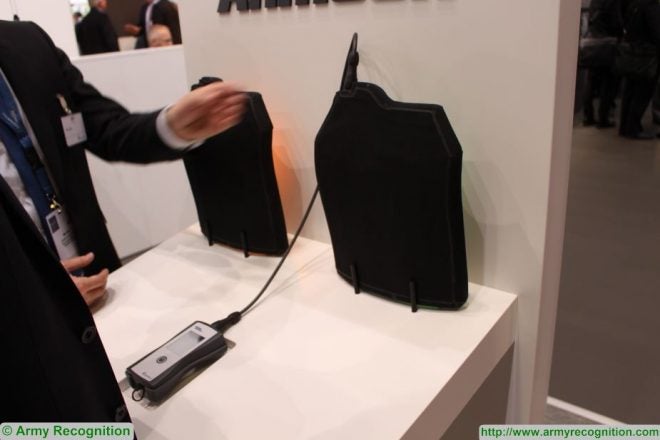Rheinmetall has introduced a new take on the ability to check ceramic or metal plates used in plate carriers and vests by Military/LE/Security forces across the world. The idea is to have an extremely lightweight system of electrical wires hooked up to a users plates. These wires (which weigh 60 grams) are designed to sense if there are cracks or other imperfections that might develop in plates over time (Read more about the intricacies of steel and ceramic plates here). Although anyone who has ever worn a set of plates realizes the importance of not dropping them outright, the fact of the matter is that plates get treated very roughly over the course of their operational use. Jumping out of vehicles, being thrown to the ground, etc… all takes a toll on them.
Rheinmetall’s Versatile Rheinmetall Armour (VERHA) group’s solution is to wrap wires around the plate, and surround those wires with a sort of protective covering that covers the entire plate. A device is plugged into a socket that these wires are connected to, and this device will show a user a green light if the plates are safe to use, or yellow if the plates need to be replaced at the earliest opportunity. Currently, the alternative is to send a units plates through an X-Ray machine which can take precious operational time away from a unit on operations.
One of the offshoot ideas that the company has is that the technology can also be used in armored platforms for vehicles.
Polish defense magazine MilMag has a good write up of the sensing unit as well–
The idea for sensing plates appears to be a brilliant one, especially if a unit is forward deployed and in an austere environment. My question however is does the wire system need to be constantly attached in order to fully register if the plate is in working condition or not? It doesn’t appear to have any battery power within the wires by themselves, so the only time the wires would really be working is when they are connected to that device. If this is the case, I’m curious why the solution can’t be a simple contraption that one could easily strap onto a plate, then register the status of it. This way, a single platoon, or squad could have one set of these wires and simply take out each individual plate to measure the status of it. Having the wires constantly connected works, but this also exposes those wires to the same rigors that the plate carrier is going through, the daily operations of that unit, which could potentially sever or damage those wires.
 Your Privacy Choices
Your Privacy Choices

